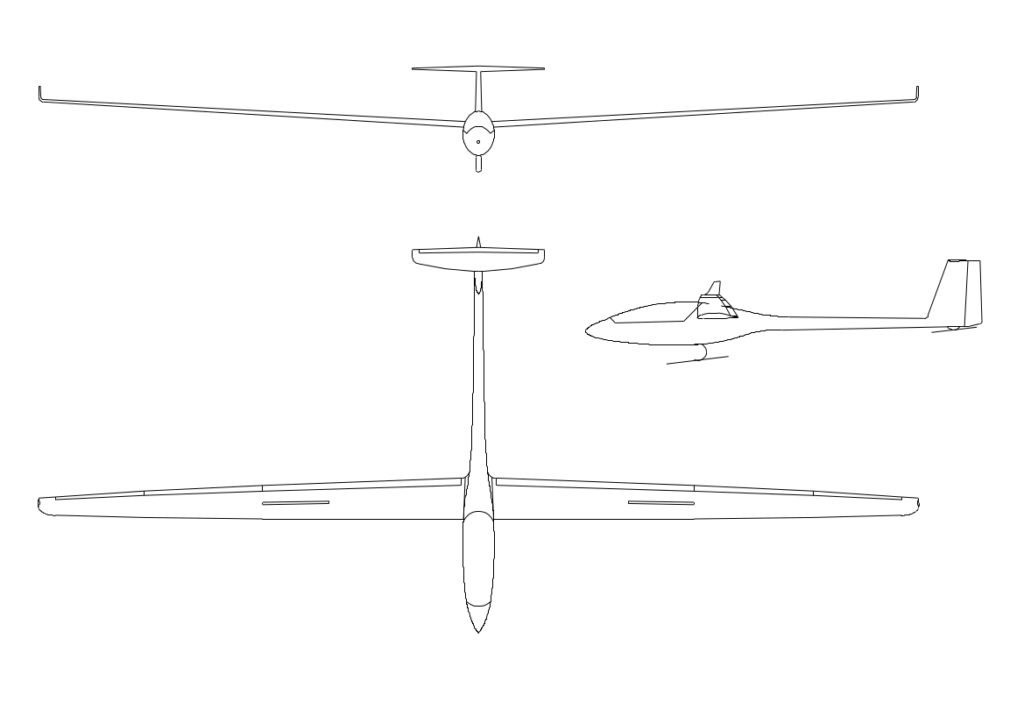A High-Performance Two-Seater
The fs33 is a high performance two-seat glider with a 20m wingspan, developed in reaction to the then newly created FAI Two Seater class in 1989. By the standards of an Akaflieg, the aircraft’s concept and design is relatively conventional. On the other hand, the optimization of the individual parts and the consequent implementation of lightweight construction were key aspects of the project. This led, among other things, to the use of carbon fiber reinforced composites for the entire structure. Only the cockpit was exempt from this, being made of a carbon-kevlar hybrid construction as with the fs31 for safety reasons. Additionally, the wing spars were made of carbon fiber scrims instead of fabric as specified by the Federal Aviation Office. The fs33 was designed to have pleasant flying characteristics to simplify operation of the aircraft.
A further consideration while planning the project was that during the 10-year long design and construction phase of the previous prototype, the fs32 “Aquila”, it was impossible for any member to actively work on the project for its entire duration. Furthermore, the demanding nature of studies with shorter periods led to the conclusion that a quick development of the aircraft had to be feasible.
To maintain the advantages of construction using negative molds without having to spend a large amount of time to construct a master model, preexisting molds were used for all major components:
- the fs31’s fuselage mold due to the former’s aerodynamic qualities
- the fs32’s wing molds, modified to remove the slotted flaps and extend the wingspan to 20 meters
- the Schempp-Hirth Nimbus 4’s tail form
Due to the usage of lengthened fs32 wing molds, the wings of the fs33 had a high aspect ratio. The skin of the wings are made from unidirectional scrims, which can be loaded even more than those from regular fabrics. The aileron and flap function of the 3-piece wing flaps are regulated by a mixer located at the wing root to maintain an elliptical lift distribution as much as possible and to allow for enough controllability and prevent spins.
Apart from the tail, the fs33’s fuselage form is identical to that of the fs31. The control system had to be totally overhauled to incorporate the flaps. To save time, as many parts from the glider manufacturer Alexander Schleicher as deemed feasible were used in the cockpit region. Adapting said parts for the fs33 was a simple operation as the ASH 25’s fuselage design was based on that of the fs31. Experience gained during the construction of the fs31 allowed for changes that made the fs33‘s cockpit somewhat roomier. The principle of splitting the fuselage into an upper and lower shell, as in the fs31, was preserved. When compared to the typical design which splits it into a left and right shell, the former allows for a higher degree of safety in the event of a crash as there is no seam under the pilot which can burst open on impact.
Originally, the retractable undercarriage was made of carbon fiber composites with steel fittings to save weight. Due to damage sustained during a crash landing however, which necessitated the construction of a new undercarriage, it was decided to replace it with a regular steel one instead.
Specifications
| Construction | 1992 – 1998 |
| First flight | 28 May 1998 |
| Wingspan | 20 m |
| Wing area | 14,4 m² |
| Aspect ratio | 27,7 |
| Profile | AH 81 K 4/20 |
| Length | 8,98 m |
| Empty weight | 408,5 kg |
| MTOW | 640 kg |
| Vne | 280 km/h |


